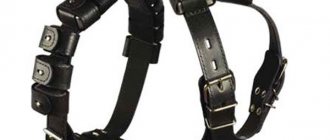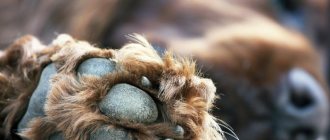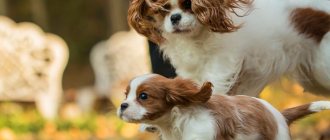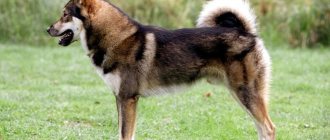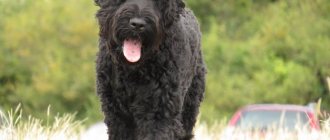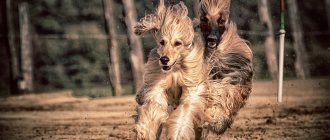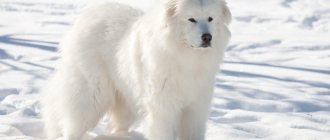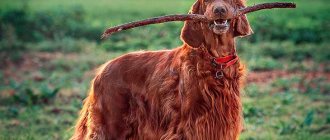Each of us, during hours of aimless wandering through the Internet, comes across a large number of various tests. Something from the series “The posture in which you usually sit (sitting, reading, falling asleep, etc.) will say everything about your character.” So similar tests exist for animals. Particularly for dogs. So, if you want to learn more about your dog - its character, its emotional state - watch how it sleeps.
Sleeping on your side.
This is the most common position in dogs. A dog that stands on its side feels comfortable in its environment, feels calm and safe, and is not on guard. The dog has trust and respect for its owner. In most cases, these are dogs that tend to be happy.
Should you let your dog sleep or sit at your feet?
Regardless of the motivation, your pet falling asleep at your feet is not a habit to worry about. This is a natural instinct for dogs and usually does not reflect anything negative.
In fact, it can be an important part of your bond and a good way to give your four-legged friend some love, care and attention.
However, if you find that your pet is suddenly spending all of his time at your feet, he may be very scared . This is due to a decrease in his self-confidence, which is a problem, because it turns out that he no longer feels safe in his own home.
If this happens, you should identify the root cause of your dog's fear and try to solve the problem.
This behavior can also become a problem if the dog's territorial or protective instinct turns into aggression and he starts barking at others or worse. If you encounter this behavior, you may want to consider additional socialization.
Additionally, your dog may have a tendency to go to extremes, and you may find that he wants to lie down at your feet at inconvenient times, such as when you're cooking, and you practically trip over him while moving. If so, you can discourage this behavior, and there are some things worth trying.
Sleep half sideways.
This pose is practically ineffective for relaxation and rest. The dog is always ready to jump up and act; the deep sleep phase does not occur. The animal is dozing rather than truly sleeping. This position is typical for guard and guard dogs. And also for those who consider themselves “in service.” Dogs often sleep in this position next to their owner - they are ready to defend him if something happens.
Factors influencing the sleep duration of a four-legged animal
Age
Puppies and older dogs spend much more time sleeping than healthy and young dogs. Puppies need more time to sleep because they grow while they sleep. For example, three-month-old babies can sleep up to 20 hours a day. Older dogs need more time to recuperate.
Breed
Representatives of large breeds also require more time to recuperate.
Weather
Just like people, weather conditions also affect our dogs. Probably every owner of a four-legged dog has noticed that on a cloudy and rainy day his pet becomes lethargic, sleepy and prefers to curl up, lie in a soft bed and snore quietly and peacefully in two holes.
Stress
The duration of sleep is often greatly influenced by stress. After the experience, the dog can sleep for a whole day. For example, our Jack, after exciting trips to the veterinary clinic, even for the usual annual vaccination, sleeps for half a day and comes to his senses.
Disease
Very often, when a dog is unwell, he may sleep longer than usual. Watch your pet. If, in addition to lethargy and weakness, other symptoms are observed (such as diarrhea, vomiting, lack of appetite, and so on), then in this case you need to seek help from a veterinarian.
Boredom
If household members are at work all day, and the four-legged one is left at home alone, then he simply has nothing left to do but sleep.
It’s another matter if the dog lives in the yard or when the family is full of children, a cat and other animals. There's no time for sleep here anymore. There's a whole bunch of things to do. Chase a cat, run after a ball with children, bark at neighbors or other people's dogs passing by. What fun! How boring it is!
Estrus
During estrus, the duration of sleep for young ladies increases. They become calm and even a little sad.
Curled up in a ball.
The so-called “fox” position is also quite common. Dogs that sleep this way have a kind, flexible and gentle character, and maybe something is bothering him. Another reason is that your pet may be simply cold and in this way it retains heat and protects its limbs.
This is interesting
It happens that dogs start digging and rustling their sleeping place before going to bed and spinning around. This is how the dog tries to create more comfort for itself, it wants to create more comfort. Often this indicates the animal’s anxiety, that it has experienced some kind of moral dissatisfaction during the day and wants, when going to sleep at night, to create a more favorable atmosphere for itself that it had during the day.
Of course, there are also poses that defy any classification. Often this becomes a subject for a photo. Puppies or hyperactive dogs who fall asleep during their pranks in a place where fatigue overtook them can fall asleep in a completely unimaginable position.
INTERESTING: Some owners notice that their sleeping dog may cluck and twitch its paws slightly in its sleep. This suggests that the dog is deeply asleep and dreaming at this moment.
Superman pose
This is one of the most adorable positions adopted by sleeping dogs. The dog sleeps lying on its stomach, with its four limbs extended and its head perfectly aligned. This is a typical position for puppies, because from this position when waking up it will be easier to jump up and start moving. If your pet has already left childhood, but continues to sleep in the Superman position, then he is still full of energy like a puppy and is ready to play noisy and energetic games.
How to wean a dog from lying down and sitting at your feet?
First, refrain from giving any kind of reward for lying on your feet. If you give your dog a good scratch behind the ears or reward him in other ways, your pet will understand that this is a positive result of his behavior and will be inclined to do so more often.
Instead, you need to encourage your dog to move away from his feet and move to a more suitable area. If she moves from your feet to her own bed, you can reward her for this action.
Make sure that you place the bed somewhere close to you, because the pet most often lies at the feet of the owner out of a desire to be close to him. If you kick your dog into another room, it will be perceived as punishment for completely natural behavior.
Based on materials from: www.labradortraininghq.com
Pose on your stomach.
In this case, the animal’s muscles remain slightly tense, and the sleep is more sensitive than in the previous point. This is usually an indication that dogs tend to be energetic, adventurous, and always ready for action and play. They are also friendly, although a little shy.
Alarm clock dog
When your pet falls asleep next to you unnoticed, but in the morning brings his wet leather nose to your face to wake you up, this means that he is very playful. Such animals do not like to sit still, they are very active and always on the alert. In addition, a four-legged dog with such a character will always protect its owner, as it loves him immensely.
Smooth and fresh skin: dermaplaning, or why a woman needs to shave her face
Lost weight: what Sofia Tarasova sacrificed for the sake of “VIA Gra” (new photos)
Rare shot: Viktoria Isakova showed her grown-up daughter from Yuri Moroz (new photo)
On the back
A position similar to “fainting” is mainly occupied by dogs living in a house and completely trusting their surroundings. This is evidenced by the fact that all the most vulnerable parts of the animal - the throat, the stomach - are completely open. This is how dogs sleep that are happy, confident and relaxed, with an easy-going nature that easily adapts to new situations. The second probable reason is that the dog has used up all its energy, overheated, and this position helps it not only relax, but also cool down.
Sleep phases
There are two phases of dog sleep: REM and NREM.
REM sleep
REM sleep is deep sleep. It is in this phase that the activity of the cardiovascular and respiratory systems becomes more active. During sleep, the dog's whiskers begin to twitch, his lips begin to twitch, and his eyes move intensely under closed eyelids. The tail begins to whine in its sleep, twitch its paws and smack its lips. It is believed that it is during this phase that the animal dreams (chases a cat, runs after a ball, or eats something tasty).
A dog's dreams, just like a person's dreams, directly depend on his lifestyle. If the dog is a hunting dog, then in a dream he will constantly run and catch prey. But if the dog is a guard dog, then in a dream it will grumble, growl and protect the house from an invisible enemy.
Despite the fact that during the rapid phase of sleep the four-legged dog behaves so restlessly, and this phase is very short and makes up only 25% of the total amount of sleep time, it is still deep sleep and the nervous system also rests.
slow sleep
Slow or light sleep is characterized by decreased muscle tone. The dog's breathing normalizes and calms down, and the heart rate slows down. NREM sleep is characterized by the absence of dreams and serves to restore the dog's physical strength.
Continuing our research, let's talk about why, when going to bed, the dog begins to spin like a top.
Fantastically awkward position
If your dog sleeps in some amazing, amazing, completely impossible position, there are two versions. Is your dog very tired or is he a big original! In any case, take a photo of it and share it with the audience - you are guaranteed a flurry of emotions and likes!
Well, in any case, no matter what sleeping position your pet chooses, the main thing is that he gets a good night's sleep and wakes up rested, cheerful and ready for new tricks!
Why, when going to bed, does the dog begin to spin around and “dig” its sleeping place?
This behavior of the four-legged animal is caused by the genetic memory of its ancestors - wolves. When going to bed, the wolves would tear up leaves or snow to make something like a nest, and then spin around in place, crushing the grass underneath them and preparing a rookery.
The fact is that the safest and most functional sleeping position for a wolf was the “ring” or “curl”. In this position, the animal loses less heat, instinctively protects all vital organs, and the walls of the constructed “nest” also protect it from the outside. That’s why, obeying the call of our ancestors, our fluffy (and not so fluffy) little tails love to “dig” their bed before going to bed.
